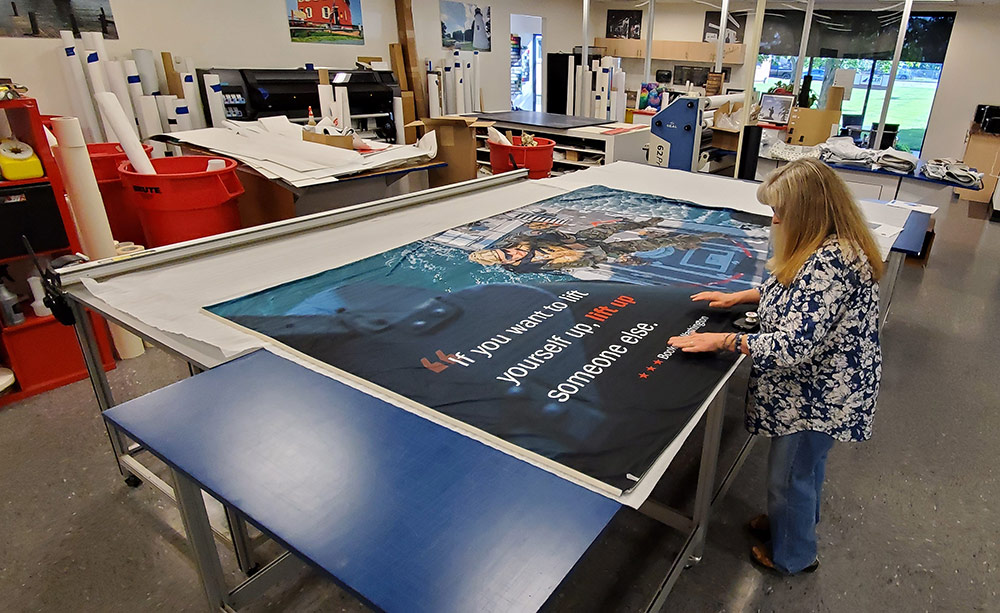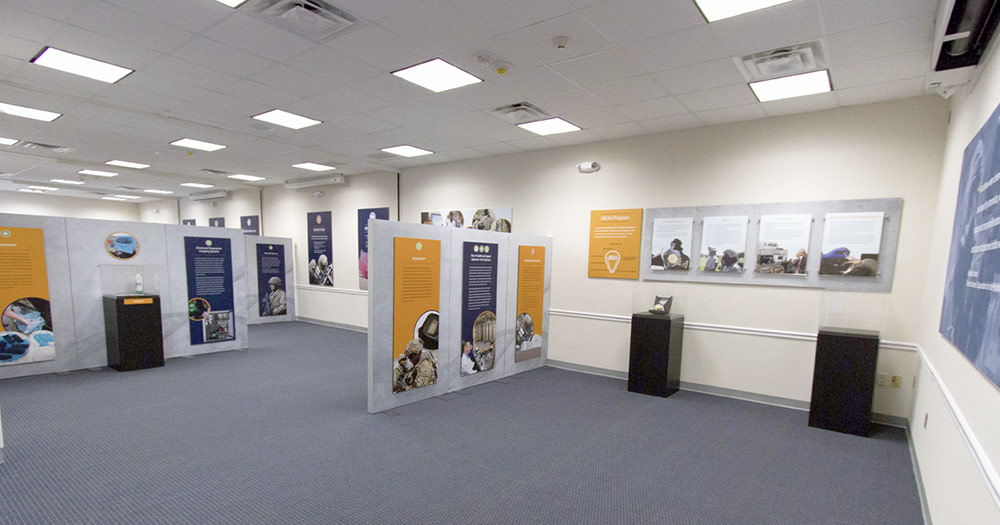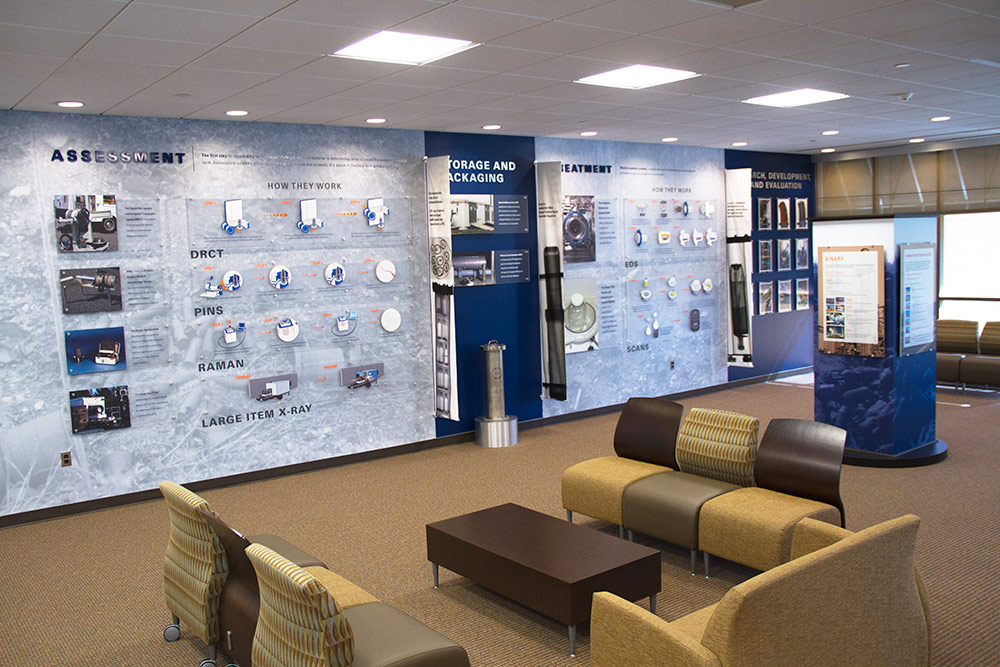A wall project is a huge undertaking, no matter the client or the size of the space. A wall project comes with lots of detail, a unique category of preciseness and new and different physical design challenges. But even with all of this, wall projects also provide wonderful opportunities, allowing businesses to tell brand stories in a big way.
To get a better picture of the creativity, ingenuity and what’s at stake when designing and managing a wall project (including the plethora of last-minute decisions that all too often pop up), we thought it was a great opportunity to chat about the topic of the day with our own inhouse expert.
No one understands the intricacies of wall projects better than Senior Director of Graphic Services, Lisa Condon. At present, detailed measurements, mockups, colorful swatches and samples for an upcoming environmental display project take up every inch of her workspace. So, let’s get right to it —
ABI: First, why would you recommend a wall project? How does a wall project support a brand?
LC: A wall project is a way of brand storytelling at a large scale. We always ask clients “How do you want people to experience your brand?” Understanding the essence of the brand, how you want people who interact with you to feel, and what you want them to learn about you, is something that can be ignited when people encounter your brand through the space. The brand experience is a critical component to communicating who you are to audiences. Wall graphics grab attention, with different colors, textures and materials. They can have many uses. Storytelling is just one way, and we’ve supported the brands of clients, telling their story successfully through this medium.

ABI: Do clients typically request a wall project, or have a direction in mind?
LC: Sometimes they do come to us with a wall project in mind. Other times, we may recommend one if we see they have space to do something amazing – something that can transform and create an impact.
In working with clients, they might have some thoughts or an idea of what they’re looking for, but typically they look to us, as the expert, for our recommendations. For instance, we may hear that a client wants to brief people and introduce them to the brand and use the surrounding office space or an entryway as a means to do so. In other cases, a wall project may be developed as a means to boost morale, inspire or reinforce the importance of the work being done by the organization to the workforce. Others are designed to prompt conversations with visiting stakeholders and show capabilities in an interesting way.
ABI: What’s an example of an inspirational project?
LC: One of my favorite projects was for Defense Logistics Agency (DLA). We have completed several wall projects throughout their headquarters building and auditorium. They all represent the DLA mission and who DLA supports, the warfighter. The wall graphics, exhibits and displays are meant to be inspirational to the workforce, but also serve as a reminder of the larger impact of their work. The wall designs and displays created help keep the team at DLA focused on the important contributions they make every day, supporting the troops that rely on their services and our country overall.

ABI: What are briefings? Any examples?
LC: A few of our Chemical Biological Defense Program clients completed wall projects that were designed specifically for briefings and tours. They were used to showcase their capabilities and highlights what they have done to support the warfighter.
ABI: What’s a commonality among all large display and wall projects that makes them unique?
LC: They’re innovative solutions. Designs sometimes need updated as the client wants, so we have to design around future needs like organizational name changes and leadership changes. We also consider the fact that once we’re finished, other people might be responsible for making updates, so we want to make it easy to update as well. A lot of thought goes into the projects so they work in ways they might be needed for in the future. We work with some amazing vendors who handle some of the custom building, fabrication and installation as well as large format printing.


ABI: What types of spaces make for good projects?
LC: Big lobby, wide hallways, building entrances, feature wall all make good spaces for wall projects. In many cases plain walls need spiced up and organizations have great stories to tell. It doesn’t have to be the perfect, large, plain wall or space. You’d be amazed at some of the different types of, what was thought to be unusable, areas that we’ve been able to transform.


ABI: How many wall projects have you worked on in your career?
LC: At least 20 or more projects.
ABI: What value do the finished products give the customer? Visitor?
LC: Depending on the goal, a sense of purpose and mission. The displays tell big stories in big ways. Beyond that, the designs look amazing and engage people.

ABI: What are some key factors people should consider before embarking on a wall project?
LC: Do you have space, budget and time? Do you have a story you want to tell? Do you have access to great images that are high resolution for large printing? Do you have permission to put things on the wall or remodel the current state of the space? Those are all things good to know ahead of time, but either way, we’re also experienced at problem-solving and generating new solutions.

Wall projects help tell your brand story in a big way and while they all have their unique set of complexities, the final outcome is always worth the effort. So, look around your space (or consider from your home office) the space people will come back to post-pandemic, where visitors will be welcomed, clients and customers will be introduced and where employees will come to carry out the mission and vision of your company or organization. How could the walls of your office be used to tell a story, evoke emotion and inspire others to act?
